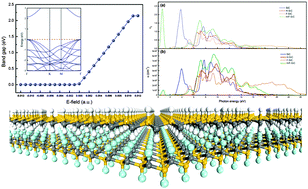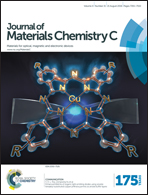Tunable electronic structure and enhanced optical properties in quasi-metallic hydrogenated/fluorinated SiC heterobilayer†
Abstract
Graphene-like silicon carbide (SiC) has emerged as a rapidly rising star on the horizon of two-dimensional (2D) layered materials. In this work, we execute a systematic theoretical investigation of the atomic and electronic structure of a fully hydrogenated/fluorinated SiC (H/F-SiC) heterobilayer, which has a quasi-metallic character in its most stable stacking pattern, to predict its electronic and optical properties. We demonstrate that a direct band gap at the Γ point can be opened in the quasi-metallic H/F-SiC heterobilayer by applying an external electric field (E-field). Especially, when altering the strength of the E-field, this system undergoes a transition from quasi-metallic state to semiconductor. We predict that the mobilities are rather high due to the low carrier effective mass and high Fermi velocity. Light absorption spectra indicate that the H/F-SiC heterobilayer has evident infrared light absorption, and complete electron–hole separation can enhance the photocatalytic efficiency. Our findings pave the way for experimental research on the development of 2D material science using weak interlayer interactions and indicate the great application potential of the H/F-SiC heterobilayer in future nanoelectronics and optoelectronics.

- This article is part of the themed collection: 2016 Journal of Materials Chemistry C Hot Papers

 Please wait while we load your content...
Please wait while we load your content...